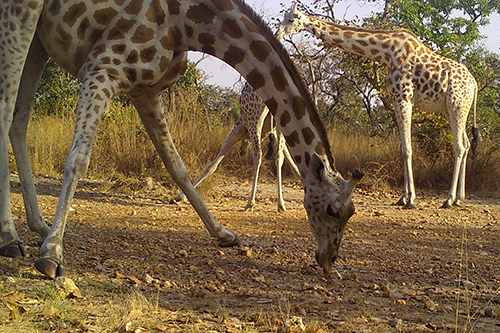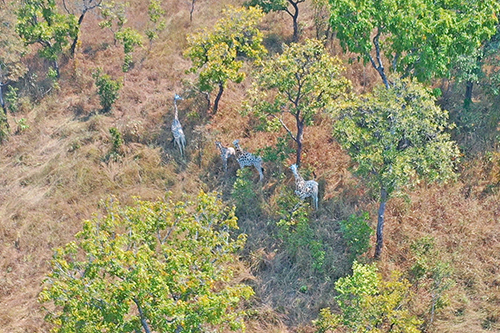Researchers from the University of Bristol and Bristol Zoological Society have carried out a three-year study using imagery of giraffe from a variety of sources, including camera traps, to establish how many of the highly threatened mammals remain within the park.
Their findings, which have been published in the African Journal of Ecology, present the first reliable estimate of giraffe population size for the region and will help conservationists monitor the threats they are facing.
The paper concluded that as few as 27 individuals remain within the park, highlighting the vital importance of ongoing efforts by Bristol Zoological Society and others to minimise threats from poaching and mounting human pressures.
Giraffe in the park are a target for illegal hunting, which poses a serious threat to the population. An alarming recent study, also led by Bristol Zoological Society and University of Bristol, found that without intervention, poaching of just two Kordofan giraffe per year could result in extinction of the population in just 15 years.
The Society has been working to conserve giraffe in Cameroon since 2017. It is thought there are fewer than 2,000 Kordofan giraffe remaining in the wild – a decline of 85% since the 1980s.
The paper’s lead author, Connor Parks, undertook the study as part of his Master’s in Global Wildlife Health and Conservation at Bristol Vet School, in conjunction with teaching partner Bristol Zoological Society. Connor is among more than 400 students who annually undertake one of the six degrees the Society offers, in partnership with UWE, the University of Bristol and SGS College.
Connor Parks explained: "Our study has shown a significant population of Kordofan giraffe still occur within the park, with many more living in the surrounding landscape. It also emphasises that continued conservation efforts are vital if we are to further support the subspecies in Cameroon. This should include strengthening existing anti-poaching regulations and protecting wildlife movement corridors."
Dr Caspian Johnson, a conservation scientist and lecturer at Bristol Zoological Society said: "Habitat degradation and illegal hunting has already seen the loss of cheetah, black rhino, and all resident elephants from Bénoué National Park. It is paramount we do not lose another precious species from this area.
"These studies provide us with the crucial baseline data needed to determine how giraffe population size and structure may change in the future. This will help us inform the conservation action and management practices needed to protect giraffe in Bénoué National Park."
Papers
'Preliminary population estimate of Kordofan giraffe (Giraffa camelopardalis antiquorum) in two areas of the Benoué complex, Cameroon' by Connor Parks, Caspian Johnson et al. in African Journal of Ecology [open access]
'Viability analysis of Kordofan giraffe (Giraffa camelopardalis antiquorum) in a protected area in Cameroon' by Kane P. J. Colston, Caspian L. Johnson et al. in African Journal of Ecology

